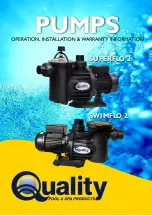
5
3.a Connect the pressure gauge to the tap in the discharge and,
if required, in the suction flange. Position dial face to facilitate
reading.
3.b Make drain pipe connections. Route piping so that it will not
interfere with normal maintenance procedures.
3.c If packing gland bypass line is to be installed use the following
chart to determine correct configuration.
4. Electrical Connections
4.a All connections to the motor such as main leads, space heat-
er leads, winding protection leads, etc., should be made in
accordance with prevailing specifications.
4.b Motor wiring can be identified by the following designations:
H – Space Heaters
P – Thermostats
T – Main leads (connect per nameplate and voltage
required) on motor.
B: STORAGE
B1: CONSIDERATIONS
When a pump is made for use in a sump or a can, it is usually
a short coupled or close coupled pump assembly. Short coupled
pump assemblies are usually shipped assembled but with the
driver separate. Storage for such a pump is an easy matter. See
Section B3 below.
Pumps used for deep sump or well applications on the other
hand, tend to be deep setting pumps. These are shipped unas-
sembled. The unassembled pieces are generally the driver, the
discharge or motor stand, column pipe, tube and shaft assem-
blies, and the bowl assembly. The following is a general list of
storage suggestions.
B2: GENERAL HINTS
As stated in Section A1 INSTALLATION of this manual, it is a
very good idea to make sure all of the necessary items ordered
are received without damage.
1 After uncrating/unpackaging and checking that all items were
received in good order, recrate and package all items in the
same manner that they were received. Clearly label each
package as to the contents and use in the assembly.
2. If more than one size and/or model of pump is ordered, take
special care not to confuse like items, such as valves, gauge,
bolts and hardware, or spare parts, for the two or more pumps.
3. Group parts according to their stage of assembly. Example:
bowls first, column and shafting second, discharge third, and
so on. This will save searching for the proper parts and hard-
ware at any given point during assembly.
B3: SHORT COUPLED PUMPS
1. Cover suction and discharge ports to prevent entrance of any
foreign materials.
2. Cover all other miscellaneous holes, i.e. pressure relief, pre-
lube and pressure gauge holes, etc.
3. Avoid exposure to weather and elements: either store indoors
or cover with a tarp.
4. Use a support framework so that no side pressure is exerted
on the pump when placed in storage.
C: ELECTRICAL
D: OPERATION
D1: PRIOR TO START-UP
1. Perform initial servicing on the driver as recommended by
the driver manufacturer. Also perform initial servicing on all
auxiliary assemblies if required.
2. Recheck all fasteners and fittings for tightness.
3. If the air release is manual or if air vent is automatic but
equipped with a valve, make certain the valve is opened
partially but not all of the way.
4. If there is a control valve on the discharge side of the pump,
make certain it is partially open so that the pump will not be
damaged if normal back pressure is not available until the
line is filled.
9. Bump starter to insure that the unit has correct rotation.
D2: INITIAL START-UP
1. Energize starter. After pump has come up to the rated speed
and all air has been exhausted, regulate control valve to
achieve desired pressure.
2. If the air release is manual, close it off after air is exhausted.
If air release is automatic, determine if the air was exhausted
too quickly (which causes the pump to jerk violently when the
valve is closed) or too slowly and regulate manual valve or
throttling device to correct this.
3. Check all joints for leakage and correct if evident.
4. Make certain the driver is operating satisfactorily as to tem-
perature, bearing temperature, etc., as prescribed by the driver
manufacturer.
5. Check for excessive vibration. If this is evident, shut down
unit immediately and begin checking for the cause.
6. If pump is equipped with packing, adjust the packing gland
(see Sections G4.h and G4.i) to allow some leakage past the
packing.
D3: ROUTINE/NORMAL
1. Start the pump in accordance with the starting equipment
used.
2. Driver lubricants should be checked following the instructions
in the Motor O & M manual attached.
3. The packing gland should be checked for proper leakage.
D4: SHUTDOWN/EMERGENCY
1. Shutdown in accordance with the starting equipment used.
Refer to Section H (Trouble Shooting) for further instructions.
E: FIELD TESTS
When a field test of the pump’s performance is required,
make the following readings: Volume, Total Head and Horsepower
Measurements, Rotating Speed and Liquid Temperature. Compare
the results of the field test with performance curve for your pump.
All volume, total head and efficiency guarantees are based
on a shop test when handling clear, cold, fresh water at a tem-
perature not exceeding 85° F and under certain specified suction
conditions.
(1) Volume (Capacity) Measurement – Measure the rate of flow
from the pump discharge in gallons per minute. The volume
measurement may be made using any one of the following
pieces of equipment: A calibrated Venturi meter, a thin-plate
calibrated orifice, a calibrated pilot tube, or an accurately
measured reservoir.
WARNING: If unit is equipped with VFD (Variable
Frequency Drive), consult the factory for minimum and
critical pump speeds before start-up.






























